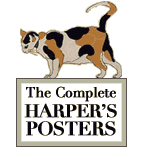The Complete Harper’s Posters, 1893-1899
Notes
| A1 | “Sometimes cited” Victor Margolin, American poster rennaisance: the great age of poster design, 1890-1900
(New York: Watson-Guptil, 1975), 32. Margolin incorrectly established Penfield’s comprehensive sketch as the first poster,
and has been frequently cited in subsequent works.
“poster deadline” Walt Reed, Society of Illustrators hall of fame: Edward Penfield, Society of Illustrators website: accessed 1 Aug 2015. “two years later” TLS, Edward Penfield to John N. Hilliard, 7 Dec 1895; collection of the author. |
| A2 | “only an experiment” EP to John Hilliard, 7 Dec 1895.
“unlike anything” in Herbert Stone, ‘Mr Penfield’s posters,’ The Chap-Book, vol 1, no 10 (Oct 1894), 147-150. See also: Will H. Clemens, The Poster, vol 1, no 2 (Feb 1896). 22. Clemens plagerized freely from Stone’s earlier article: “Mr Penfield has scored remarkable success with his posters. His first production for Harper’s Magazine appeared in April, 1893. It was a poster which forced itself upon one; in design and color it was striking, and yet it was supremely simple throughout. A very gentlemanly man walked down the salmon foreground arrayed in all the gorgeousness of a green driving coat. On his head was a light fore-and-after, and his gloves were ‘London Tan.’ The rain was falling all around him, but with charming nonchalance and flattering inentions he read a copy of Harper’s. The poster was distinctly successful; it was theoretically as well as practically good.” “freshly returned” is from Auther Lubow, The reporter who would be king: a biography of Richard Harding Davis (New York: Charles Scribner’s Sons, 1992), 99; and also Henry Cole Quinby, Richard Harding Davis: a bibliography (New York: E.P. Dutton and Company, 1924), 32-33. “on numerous” Eugene Exman, The house of Harper: one hundred and fifty years of publishing (New York: Harper & Row, 1967), 178. “first I had seen” EP to John Hilliard, 7 Dec 1895. |
| A19 | “The couple” David Kiehl, American art posters of the 1890s. |
| A28 | Hillier incorrectly dated this poster as from 1894, an error later picked up by Wong. |
| A29 | “failed investments,” Clemens started his own company to publish his works, and later invested in the Paige typesetting machine.
Both enterprises failed by 1895. Exman, The house of Harper,156.
“round out” and “in France” are also from Exman, 156-157. “grave mistake” is from J. Henry Harper, I remember... (New York and London: Harper & Brothers, 1934), 139. “blatantly advertised” The write-up for ‘Joan of Arc’ was positioned just below that for ‘Tom Sawyer, Detective,’ with Clemen’s portrait in between; in Harper’s Magazine Advertiser, Harper’s New Monthly Magazine, vol 91, no 546 (Nov 1895), 1. “several writers” Harper, 140. “Berhardt dramatized” Sarah Bernhardt operated the Theatre Porte Saint-Martin from 1883 until 1893, when she became the proprietess of the Theatre de la Renaissance. As part of her repertoir, Bernhardt appeared as Jeanne d’Arc frequently throughout the rest of her career, eventually on tour in America. Her original production from 1890 is detailed in Victor Arwas, Berthón and Grasset (New York: Rizzoli, 1978), 42. Grasset’s poster is mentioned as from 1893 in Stanley Appelbaum, The complete “Masters of the Poster,” (New York: Dover Publications, 1990). |
| A32 | “Kaiser Wilhelm” and “treason” Davis couldn’t stand Bigelow (described by Arthur Lubow as a ‘womanizer, a racist, and a lout’), nor his seemingly unpatriotic reporting, to the point of publically trading jibes against him in the papers. Lubow, The reporter who would be king,164-166, and Peggy and Harold Samuels, Frederic Remington; a biography (Garden City, NY: Doubleday & Company, 1982), 169, 177. |
| A38 | “founded in 1883,” The National Horse show has been held every November since 1883, usually at Madison Square Garden in New York. The original
membership of the association was used as the basis for the New York Social Register.
“contains the portrait” Will H. Clemens, The Poster, vol 1, no 2 (Feb 1896), 22. |
| A41 | “praise from” is from Clemens, The Poster, vol 1, no 1 (Jan 1896), 2. Sir Hubert Von Herkomer (1849-1914) was the reigning dignitary of English ‘posterists,’ an artist-engraver who preferred designing woodblock prints, and frequent contributor to such publications as The Magazine of Art, The Palette and the weekly Graphic. |
| A42 | “new interpretation” in Harper’s Magazine Advertiser, Harper’s New Monthly Magazine, vol 91, no 546 (Nov 1895), 2.
Henry Mills Alden to Howard Pyle, 20 Aug 1895; quoted in Charles D. Abbott, Howard Pyle: a chronicle (New York: Harper & Brothers, 1925),157-158. “especially delightful” and “frame some” in Abbott, Howard Pyle: a chronicle,158. “were begging” in Abbott, Howard Pyle: a chronicle,159. |
| A48 | “lasting charm” is from Charles Matlack Price, ‘The cat and the poster,’ Arts and Decoration, (Sep 1912). See also Price’s Posters: a critical study of the development of poster design in continental Europe, England and America (New York: G.W. Bricka, 1913). |
| A49 | “elusive woman” and “Lautrec executed” are from Phillip Dennis Cate and Susan Gill, Théophile-Alexandre Steinlen (Salt Lake City, UT: G.M. Smith, 1982). |
